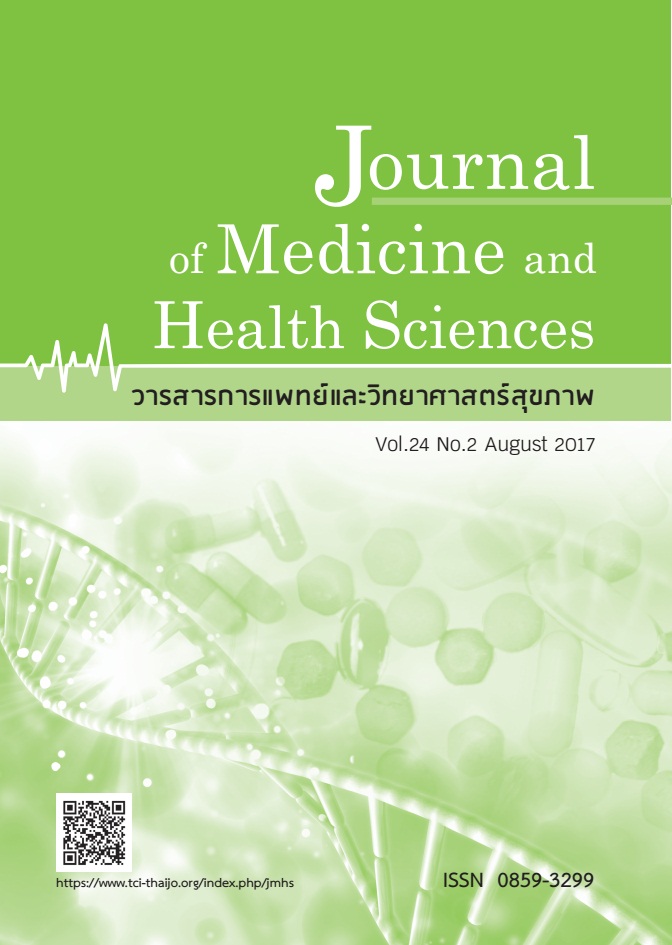ปัจจัยที่มีความสัมพันธ์ต่อการติดเชื้อ Pseudomonas aeruginosa ในกระแสเลือด ในผู้ป่วยที่เข้ารับการรักษาในโรงพยาบาลจังหวัดร้อยเอ็ด (Factors associated with Pseudomonas aeruginosa bloodstream infection among admitted patients of Roi Et Hospital)
Keywords:
Pseudomonas aeruginosa, ปัจจัยเสี่ยง, ติดเชื้อในกระแสเลือด/Pseudomonas aeruginosa, Risk factor, Bloodstream infectionAbstract
บทคัดย่อ
เชื้อ P. aeruginosa เป็นเชื้อโรคฉวยโอกาสที่พบได้บ่อยในผู้ที่มีภูมิคุ้มกันต่ำหรือผู้ป่วยที่พักรักษาตัวในโรงพยาบาลเป็นเวลานาน ผู้ป่วยที่ติดเชื้อชนิดนี้จะมีความเสี่ยงในการเสียชีวิตเพิ่มสูงโดยเฉพาะการติดเชื้อในกระแสเลือด วัตถุประสงค์ของการศึกษาเพื่อศึกษา วิเคราะห์หาปัจจัยที่มีความสัมพันธ์ต่อการติดเชื้อ P. aeruginosa ในกระแสเลือดในผู้ป่วยที่เข้ารับการรักษาในโรงพยาบาลร้อยเอ็ด โดยรูปแบบการศึกษาแบบ Case-control study ใช้อัตราส่วน 1: 1 โดยดำเนินการเก็บรวบรวมข้อมูลจากเวชระเบียนและผลการตรวจเพาะเชื้อในเลือดของผู้ป่วยที่ได้เข้ารับการรักษาที่โรงพยาบาลร้อยเอ็ด ระหว่างวันที่ 1 มกราคม พ.ศ. 2557 ถึงวันที่ 31 ธันวาคม พ.ศ. 2558 ตัวแปรที่สนใจ ได้แก่ ข้อมูลทั่วไปของผู้ป่วย ข้อมูลการทำหัตถการ และประวัติการรักษา โดยสถิติที่ใช้ในการวิเคราะห์ข้อมูล ได้แก่ สถิติเชิงพรรณนา การวิเคราะห์ตัวแปรเชิงเดี่ยว และการวิเคราะห์เชิงพหุแบบพหุถดถอย ผลการศึกษา พบว่ากลุ่มศึกษาจำนวน 89 ราย ส่วนมากเป็นเพศชาย ร้อยละ 55.10 อายุเฉลี่ย 57.62+16.18 ปี กลุ่มควบคุม มีจำนวน 89 รายส่วนมากเป็นเพศหญิง ร้อยละ 51.70 อายุเฉลี่ย 56.55+ 16.89 ปี จากการวิเคราะห์ข้อมูลพบว่าปัจจัยเสี่ยงต่อการติดเชื้อ P. aeruginosa ในกระแสเลือดในผู้ป่วย ได้แก่ ผู้ป่วย การนอนในโรงพยาบาลมากกว่า 7 วัน(OR Adjusted= 2.40 ; 95% CI: 1.33-4.52) การมีภาวะแทรกซ้อน (OR Adjusted = 2.50 ; 95% CI: 1.39-4.64) การได้รับการใส่เครื่องช่วยหายใจ (OR Adjusted.= 2.20; 95% CI: 1.17-4.31) และการได้รับการใส่ท่อช่วยหายใจ (OR Adjusted= 2.20 ;95% CI: 1.16-4.22) โดยสรูป ผู้ป่วยที่นอนรักษาตัวในโรงพยาบาลเป็นเวลานาน มีภาวะแทรกซ้อนและที่ได้รับการทำหัตถการบางชนิดจะมีความเสี่ยงต่อการติดเชื้อ P. aeruginosa ในกระแสเลือด โดยผู้ป่วยกลุ่มที่มีความเสี่ยงดังกล่าว ควรจะมีมาตรการเฝ้าระวังและควรได้รับการดูแลเป็นพิเศษเพื่อเป็นการควบคุมและป้องการติดเชื้อ P. aeruginosa ในกระแสเลือดที่อาจจะเกิดขึ้นได้
Abstract
Nosocomial infection caused by P. aeruginosa is frequently found among patient with low immunity or long term hospital patients. The infected patients had a high mortality rate, especially due to septicemia. The aim of this study was to investigate the factors associated with P. aeruginosa bloodstream infection among patients at Roi Et Hospital. The methods was a case control study (Control: cases = 1:1). All data were collected from medical records and blood culture tests from the microbiology laboratory of admitted patients in Roi Et Hospital, Roi Et Province between January 1, 2014 to December 31, 2015. The variables which were interest included general information, invasive medical procedures and treatment history. The statistical analyses employed descriptive statistics, univariate analysis and multivariate analysis by multiple logistic regressions. In term of the results, there were eighty nine cases most of them were male (55.10%) with mean age 57.62 + 16.18 years and eighty nine controls, the majority were female (51.70%) with mean age 56.55 + 16.89 years. The risk factors for P. aeruginosa bloodstream infection were statistically significant with factors included being for admitted more than seven days (OR Adjusted = 2.40; 95% CI: 1.33-4.52), complications (OR Adjusted = 2.50 ; 95% CI: 1.39-4.64), ventilators (OR Adjusted = 2.20; 95% CI: 1.17-4.31), endotracheal tubes (OR Adjusted = 2.20 ; 95% CI: 1.16-4.22. In conclusion, hospitalized patients who has experienced complications and undergone some type of invasive medical procedure were at risk for the P. aeruginosa bloodstream infection. All patients in risk group should be provided with special guidelines and special care from medical staff for the prevention and control of the P. aeruginosa blood stream infection.



